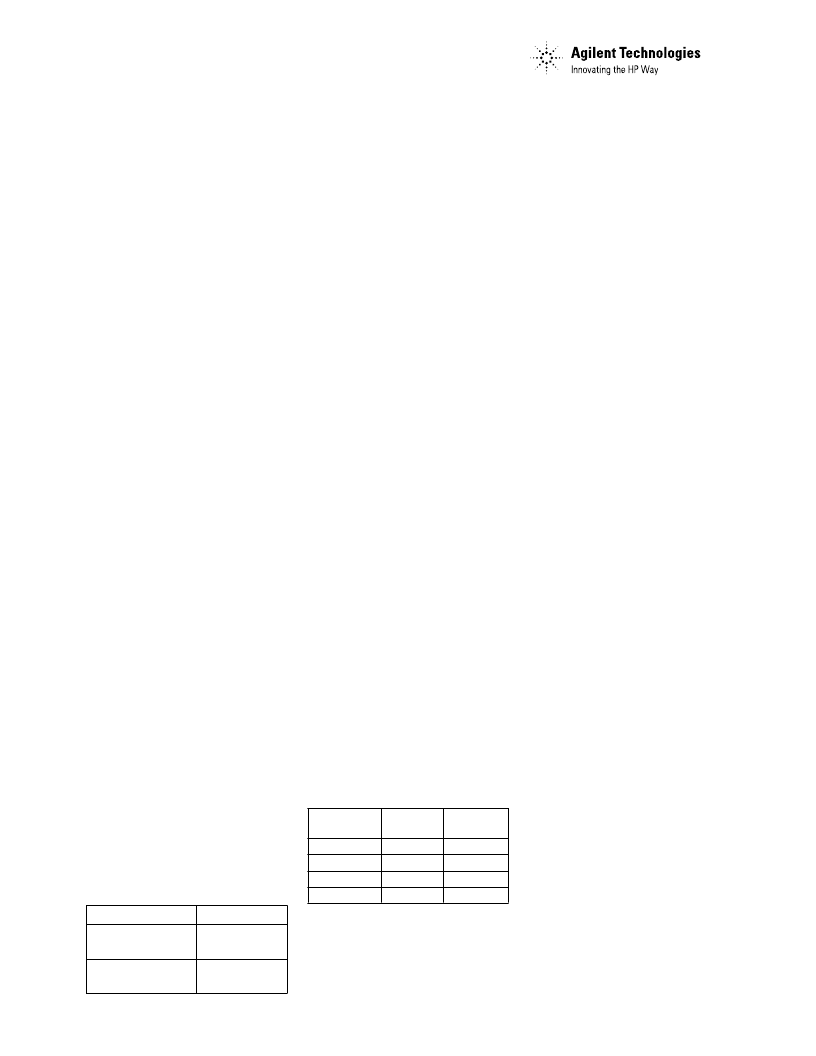- 您現(xiàn)在的位置:買賣IC網(wǎng) > PDF目錄370522 > HDSP-5530 Seven Segment Displays(七段顯示器) PDF資料下載
參數(shù)資料
| 型號: | HDSP-5530 |
| 英文描述: | Seven Segment Displays(七段顯示器) |
| 中文描述: | 七段顯示器(七段顯示器) |
| 文件頁數(shù): | 8/8頁 |
| 文件大?。?/td> | 219K |
| 代理商: | HDSP-5530 |

dc current (I
PEAK
MAX/I
DC
MAX).
Figure 2 presents the maximum
allowed dc current vs. ambient
temperature. Figure 1 is based on
the principle that the peak junc-
tion temperature for pulsed
operation at a specified peak
current, pulse duration and
refresh rate should be the same
as the junction temperature at
maximum DC operation. Refresh
rates of 1 kHz or faster minimize
the pulsed junction heating effect
of the device resulting in the
maximum possible time average
luminous intensity.
The time average luminous inten-
sity can be calculated knowing
the average forward current and
relative efficiency characteristic,
η
|PEAK
, of Figure 3. Time average
luminous intensity for a device
case temperature of 25
°
C, I
V
(25
°
C), is calculated as follows:
I
20 mA
I
V
(25
°
C) =
[
–––––
]
[
η
|PEAK
] [I
V DATA SHEET
]
Example: For HDSP-4030 series
η
|PEAK
= 1.00 at I
PEAK
= 100 mA.
For DF = 1/5:
20 mA
20 mA
I
V
(25
°
) =
[
––––––
]
[1.00][4.5 mcd]
= 4.5 mcd/segment
The time average luminous inten-
sity may be adjusted for operat-
ing junction temperature by the
following exponential equation:
I
V
(T
J
) = I
V
(25
°
C) e
[k(TJ + 25
°
C)]
where T
J
= T
A
+ P
D
R
θ
J-A
Mechanical
These devices are constructed
utilizing a lead frame in a
standard DIP package. The LED
dice are attached directly to the
lead frame. Therefore, the
cathode leads are the direct
thermal and mechanical stress
paths to the LED dice. The
absolute maximum allowed
junction temperature, T
J
MAX, is
105
°
C. The maximum power
ratings have been established so
that the worst case V
F
device does
not exceed this limit.
Worst case thermal resistance
pin-to-ambient is 400
°
C/W/Seg
when these devices are soldered
into minimum trace width PC
boards. When installed in a PC
board that provides R
θ
PIN-A
less
than 400
°
C/W/Seg these displays
may be operated at higher
average currents as shown in
Figure 2.
Optical
The radiation pattern for these
devices is approximately Lam-
bertian. The luminous sterance
may be calculated using one of
the two following formulas.
I
V
(cd)
A(m
2
)
L
V
(cd/m
2
) = ––––––
I
V
(cd)
A(ft
2
)
L
V
(footlamberts) = –––––––
Contrast Enhancement
The objective of contrast enhance-
ment is to optimize display
readability. Adequate contrast
enhancement can be achieved in
indoor applications through
luminous contrast techniques.
Luminous contrast is the
observed brightness of the
illuminated segment compared to
the brightness of the surround.
Appropriate wavelength filters
maximize luminous contrast by
reducing the amount of light
reflected from the area around
the display while transmitting
most of the light emitted by the
segment. These filters are
described further in Application
Note 1015.
Chrominance contrast can further
improve display readability.
Chrominance contrast refers to
the color difference between the
illuminated segment and the
surrounding area. These displays
are assembled with a gray package
and untinted encapsulating epoxy
in the segments to improve
chrominance contrast of the ON
segments. Additional contrast
enhancement in bright ambients
may be achieved by using a
neutral density gray filter such as
Panelgraphic Chromafilter Gray
10, or 3M Light Control Film
(louvered film).
Device
-3530/-3730/
-5530/-3900
-4030/-4130/
-5730/-4200
K
-0.0131/
°
C
-0.0112/
°
C
Area/Seg. Area/Seg.
mm
2
2.5
4.4
8.8
14.9
Device
-3530/-4030
-3730/-4130
-5530/-5730
-3900/-4200
in
2
0.0039
0.0068
0.0137
0.0231
www.semiconductor.agilent.com
Data subject to change.
Copyright 1999 Agilent Technologies, Inc.
Obsoletes 5953-7714 (12/81)
5964-6374E (11/99)
相關(guān)PDF資料 |
PDF描述 |
|---|---|
| HDSP-4030 | Seven Segment Displays(七段顯示器) |
| HDSP-6xxx | Seven Segment Displays(七段顯示器) |
| HDSP-5xxx | Seven Segment Displays(七段顯示器) |
| HDSP-3xxx | Seven Segment Displays(七段顯示器) |
| HDSP-4xxx | Seven Segment Displays(七段顯示器) |
相關(guān)代理商/技術(shù)參數(shù) |
參數(shù)描述 |
|---|---|
| HDSP-5531 | 制造商:Hewlett Packard Co 功能描述: |
| HDSP-5537 | 功能描述:LED 顯示器和配件 Red 626nm 0.56in RoHS:否 制造商:Avago Technologies 顯示器類型:7 Segment 數(shù)位數(shù)量:2 字符大小:7.8 mm x 14.22 mm 照明顏色:Red 波長:628 nm 共用管腳:Common Anode 工作電壓:2.05 V 工作電流:20 mA 最大工作溫度:+ 85 C 最小工作溫度:- 35 C 封裝:Tube |
| HDSP-5538 | 功能描述:LED 顯示器和配件 Red 626nm 0.56in RoHS:否 制造商:Avago Technologies 顯示器類型:7 Segment 數(shù)位數(shù)量:2 字符大小:7.8 mm x 14.22 mm 照明顏色:Red 波長:628 nm 共用管腳:Common Anode 工作電壓:2.05 V 工作電流:20 mA 最大工作溫度:+ 85 C 最小工作溫度:- 35 C 封裝:Tube |
| HDSP5551 | 制造商:HEW 功能描述:HDSP5551 H.P. IN SB-154 |
| HDSP-5551 | 功能描述:LED 顯示器和配件 Red 626nm 0.56in 7 Segment RoHS:否 制造商:Avago Technologies 顯示器類型:7 Segment 數(shù)位數(shù)量:2 字符大小:7.8 mm x 14.22 mm 照明顏色:Red 波長:628 nm 共用管腳:Common Anode 工作電壓:2.05 V 工作電流:20 mA 最大工作溫度:+ 85 C 最小工作溫度:- 35 C 封裝:Tube |
發(fā)布緊急采購,3分鐘左右您將得到回復(fù)。